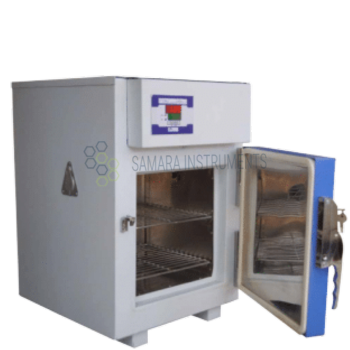
Hot Air Oven
Hot air ovens are highly popular in laboratories for dry heat sterilization, thermal testing, heat treatment, and other scientific activities. Read more
Hot Air Oven: Principle, Parts, Types, Uses
Hot air ovens are highly popular in laboratories for dry heat sterilization, thermal testing, heat treatment, and other scientific activities. This hot air oven provides a controlled and uniform level of heat to the materials to sterilize a product. Hot air oven equipment utilizes the dry heat sterilization method where all the laboratory equipment is sterilized or free from toxic or non-toxic pathogens, like viruses, bacteria, etc.
French scientist Louis Pasteur invented this dry heat sterilization process in the 1800s to keep wines or other organic beverages free from microorganisms. This technology is still utilized in pharmaceuticals, food laboratories, research purposes, etc. In all these sectors, consistent and controlled heat is provided to the materials to make food research samples or other elements long-lived without pathogen infection.
Special features of a hot air oven
Many research elements do not melt. With external heat application, those samples just change their chemical format and catch fire. For these elements, a hot air oven is applied externally, and with the dry heat, spores or pathogenic parts are destroyed. With a reduced infection level, the hot air oven helps the sample be long-lived and durable without changing taste, nature, or texture.
How does a hot air oven work?
The working principles of a hot air oven are dependent on convection, conduction, and radiation.
Step 1: The heating elements of the hot air oven create heat within the hot air oven chamber. With the fans, the hot air circulated within the hot air oven chamber.
Step 2: With hot air the external surface of the sample becomes hot and with the conduction process the heat is transferred to the lower or inner surface of the sample.
Step 3: With such heat the water inside the sample gets evaporated and all the cellular microorganisms like viruses, and bacteria get killed or removed from the sample by oxidative damage and denaturation of pathogenic proteins. Time-specific external heats to the samples help in the elevated level of electrolytes and microorganisms become dead. It helps to make the samples long-lived without any chemical additives.
Parts of hot air oven:
Cabinet & chamber: This part is made of aluminum or stainless steel. It helps to protect the entire instrument to be free from electrical shocks, heat loss, or other hazards.
Fiberglass: In the mid-space between the outer glass and the inner chamber there is a fiber wool insulation process. There are two types of fiberglass – brown and yellow. Yellow fiberglass creates skin sensitivity. It’s crucial to use hand gloves during hot air oven utilization.
Shelves: Objects holding plates are made of aluminum. In this portion, many materials are placed.
Motorized fan / Blower: It helps to blow the hot air in the internal chamber in a controlled and consistent manner.
Door: A single door is present in front of the hot air oven with a heavy hinge. An asbestos-made door gasket is also present here to protect against heat loss.
Besides these main parts, there are heaters, electric supply points, thermostats, control panels, etc.
Application of hot air oven:
Laboratory equipment sterilization: Laboratory equipment is heat dried with a hot air oven system. It helps to produce accurate results without any deterioration of the lab samples.
Food and pharmaceutical industry: In the food and pharmaceutical industry, the hot air oven is highly utilized to achieve long life and durability of taste without external additives.
Construction industry: In this industry, different metals, alloys, or others are provided with dry heat sterilization. In this way, metal, alloys, or other construction materials become free of microorganisms and achieve a durable long life.
| Model No | Inner Chamber (w x d x h) | Volume (Liters) | Shelves | |
|---|---|---|---|---|
| (No’s) | ||||
| SI - HAO/30 | 300 x 300 x 300 mm | 30 | 2 | |
| SI - HAO/45 | 355 x 355 x 355 mm | 45 | 2 | |
| SI - HAO/95 | 455 x 455 x 455 mm | 95 | 2 | |
| SI - HAO/125 | 455 x 455 x 605 mm | 125 | 3 | |
| SI - HAO/224 | 605 x 605 x 605 mm | 224 | 3 | |
| SI - HAO/252 | 605 x 455 x 910 mm | 252 | 3 | |
| SI - HAO/336 | 605 x 605 x 910 mm | 336 | 3 | |
| Temperature Range | 5°C above ambient to 250°C maximum | |||
| Temperature Accuracy | + / - 2°C | |||
| Temperature Uniformity | + / - 1°C | |||
| Controls | PID Controller | |||
| Temp Display | LED Display | |||
| Sensor | PT-100 | |||
| Heating Element | Nichrome wire / Kanthal A1 | |||
| Safety device | Over temperature protection Electric leakage breaker Temperature safety as per DIN 12880 Class 3.1 |
|||
| Exterior Chamber | MS powder coated | |||
| Interior Chamber | 304 stainless steel | |||
| Insulation | Mineral Wool | |||
| Doors | Solid doors w/ silicone rubber gasket & lock | |||
| Shelves | 2 – 3 Stainless steel shelves (Removable) | |||
| Air Circulation | Forced air circulation | |||
| Power Supply | 220 Volts | |||
| Optional | Temperature chart recorder PLC Controller Stainless steel outer cabinet Audio / visual alarm Extra shelves Heating Thermostat |
|||
- State-of-the-art functionality
- Precise control
- User-orientated design style
- Long-lasting performance
- Excellent build quality and corrosion resistance
- Safety and Reliability
- Economic viability and efficiency
- Up to 250°C temperature
- Double walled construction
- Forced air circulation
- Noise-less fan
- Ventilation of gases
- Overheat and over-current protection
- Uniform Heating
- Digital Display and Controls
Specifications:
Construction – Our laboratory ovens are double-walled convection heated units. The outer body of our hot air oven is constructed out of a thick PCRC sheet duly pre-treated with primers and rust-proofing and painted with long-lasting stove enamel or elegantly powder coated. The inner chamber is made of a heavy gauge stainless steel sheet of SS-304 grade. The gap between the walls is filled with high-grade mineral glass wool, which ensures maximum thermal efficiency in our laboratory ovens. The unit is mounted on a sturdy steel frame and provided with castor wheels (Large-Sized Models Only) for easy movement inside the laboratory. The unit is provided with one to three stainless steel shelves (As per the inner size)
Heating: Indirect three-side heating system is provided in our units, comprising air heaters made of high-grade Kanthal A-1 wires of suitable wattage. The warm air is evenly distributed throughout the chamber through efficient motor fans ensuring very good temperature sensitivity.
Temperature Range: The temperature range of our standard laboratory oven models is RT 5 deg C to 350 deg C. However we have the capacity to modify the same to suit the individual specialized requirements of our customers.
Temperature Sensitivity: The temperature inside our hot air ovens is controlled with a sensitivity of ±1 deg C or better
Front Panel: Front panel of our units comprises on/off switches heating and mains indicator lamps, temperature controllers/Thermostat.
You May Also Like















